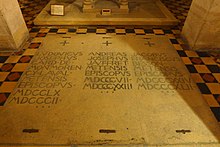Louis-Joseph de Montmorency-Laval



Louis-Joseph de Montmorency-Laval (born December 11, 1724 at Baillet Castle (or Bayers ) in the diocese of Angoulême , † June 17, 1808 in Altona adElbe ) was cardinal and bishop of Metz .
Live and act
Origin and activity in France
Montmorency-Lavals parents were Guy André de Montmorency-Laval , Marquis de Laval-Lezay (1686-1745) and Marie Anne de Turmenies de Nointel († 1756). The offspring of the nobility studied canon law at the Sorbonne in Paris and later became Vicar General of Sens . On November 7, 1753 he was promoted to Bishop of Orleans . The episcopal ordination donated him on February 10, 1754 in the Cathedral of Notre-Dame de Paris Christophe de Beaumont , the Archbishop of Paris ; Co -consecrators were Étienne-René Poitier des Gevres , Bishop of Beauvais , and Pierre de Rochechouart , Bishop of Bayeux . In 1758 he was appointed Bishop of Condom and on August 21, 1760, Prince-Bishop of Metz. In 1786, Montmorency-Laval was given the office of Grand Almosenier of France , a prestigious position at the royal court, due to which he was responsible for overseeing the religious side of life there. At the same time he was commander of the Order of the Holy Spirit . In 1787 the chief shepherd led the provincial synod of the " Trois-Évêchés " (ie the three dioceses of Metz, Toul and Verdun) and was on March 30, 1789 by Pope Pius VI. elevated to cardinal.
Exile in the Holy Roman Empire and Denmark
After the outbreak of the French Revolution , the bishop vehemently opposed the civil status of the clergy in 1790 . At the end of April 1791 he fled first to the Roman-German part of his diocese, then stayed in Trier and at the end of October 1792 traveled on to Düsseldorf . The cardinal remained loyal to the representatives of the Ancien Régime . He visited emigrants in Maastricht and at the end of October 1793 held a novena for the peace of mind of the executed Queen Marie-Antoinette in the Jesuit Church in Mannheim . Montmorency-Laval stayed in Münster for some time . There is a list in the city archives that names him and 108 other refugees who were in his entourage and others. a. his coadjutor Henri de Chambre d'Urgons (1748-1802), the episcopal brothers Jean-Baptiste du Plessis d'Argentré of Sées (1720-1805) and Louis-Charles du Plessis d'Argentré of Limoges (1723-1808), several Nobles of both sexes (including the widow of Duke Claude-Victor de Broglie with daughter and son-in-law), officers, numerous clergymen and 11 nuns. Finally, in 1796, the Metz Oberhirte went to Altona in what was then the Danish state , where he settled permanently. Little is known about his work there; apparently he was very charitable. Contemporary witnesses report that the prince of the church walked through the streets in a red coat and occasionally threw money to the children. He exercised pastoral care at the St. Joseph Church in Altona and an Aloys Kleyser is named as his altar boy, who owned a dormitory and pub nearby - on the Große Freiheit .
At the request of the later French King Louis XVIII , who was also in exile . Cardinal Montmorency-Laval married Marie Thérèse Charlotte of France ( Madame Royale ) with Duke Louis-Antoine de Bourbon on June 10, 1799 in Mitau .
Although Pope Pius VII called on all previous French bishops to resign as a result of the Concordat with Emperor Napoleon I in 1801, the cardinal refused, remained in German-Danish exile and carried on his title as Bishop of Metz until the end of his life. In 1802 his successor, Pierre-François Bienaymé, took over the bishopric of Metz on papal instructions .
The body of Bishop Louis Joseph de Montmorency-Laval was first buried in St. Joseph's Church on the Große Freiheit. In 1900 the bones were transferred from the vault to Metz and buried there on July 4th in the crypt of the local cathedral .
Personal
Bishop Montmorency-Laval was in Altona, accompanied by several French priests and his relatives Magdaleine Susanne de Paulmy d'Argenson, née. Duchess of Montmorency-Luxembourg (1751–1813), former lady-in-waiting to the executed Queen Marie Antoinette (1755–1793) of France. She ran the cardinal's household, died on February 22nd, 1813 and was also buried in the tomb of St. Joseph.
The cardinal was the great-uncle of the future French Foreign Minister Mathieu de Montmorency-Laval (1766-1826).
Web links
- Literature by and about Louis-Joseph de Montmorency-Laval in the SUDOC catalog (Association of French University Libraries)
- BBKL
- Montmorency-Laval, Louis-Joseph de. In: Salvador Miranda : The Cardinals of the Holy Roman Church. ( Florida International University website), accessed December 11, 2016.
- Entry on Louis-Joseph de Montmorency-Laval on catholic-hierarchy.org ; accessed on December 11, 2016.
- Louis-Joseph de Montmorency-Laval in the Saarland biographies
Individual evidence
- ↑ Entry on Henri de Chambre d'Urgons on catholic-hierarchy.org
- ↑ du Plessis d'Argentré.html Entry on Louis-Joseph de Montmorency-Laval on catholic-hierarchy.org
- ^ Entry on Louis-Charles du Plessis d'Argentré on catholic-hierarchy.org
- ^ To the entourage of the bishop in Munster
- ↑ The cardinal's entourage with names of the accompanying bishops
- ↑ Source on Cardinal Montmorency-Laval and his relatives or on their funerary inscriptions
| predecessor | Office | successor |
|---|---|---|
| Claude de Saint Simon |
Bishop of Metz 1760–1802 |
Pierre-François Bienaymé |
| Emmanuel de Cossé-Brissac |
Bishop of Condom 1758–1760 |
Étienne de Brienne |
| Nicolas Joseph de Pâris |
Bishop of Orléans 1753–1758 |
Louis Sextius de Jarente de la Bruyère |
| personal data | |
|---|---|
| SURNAME | Montmorency-Laval, Louis-Joseph de |
| ALTERNATIVE NAMES | Montmorency-Laval, Louis Joseph de |
| BRIEF DESCRIPTION | Cardinal, Bishop of Metz |
| DATE OF BIRTH | December 11, 1724 |
| PLACE OF BIRTH | Baillet Castle |
| DATE OF DEATH | June 17, 1808 |
| Place of death | Altona |
